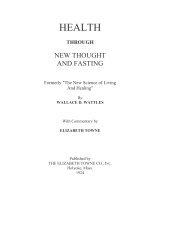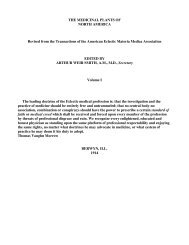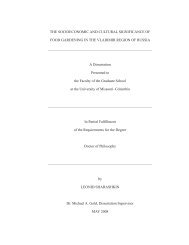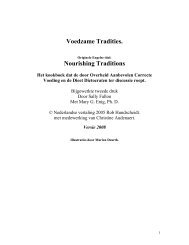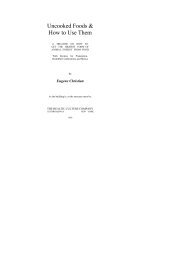FACTORS OF SOIL FORMATION - Midlands State University
FACTORS OF SOIL FORMATION - Midlands State University
FACTORS OF SOIL FORMATION - Midlands State University
Create successful ePaper yourself
Turn your PDF publications into a flip-book with our unique Google optimized e-Paper software.
the weathering of limestones based on observation periods of 50 years<br />
or less. He calculated initial weathering rates as shown in Table 5.<br />
TABLE 5.—WEATHERING RATES <strong>OF</strong> TOMBSTONES<br />
Type of Tombstone<br />
Number of Years<br />
Necessary to Produce<br />
1 In. of Weathering<br />
Kirkly Stephen 500<br />
Tailbrig "macadam" 300<br />
Penrith limestone 250<br />
Askrigg limestone 240<br />
Moisture is considered to be the major agent responsible for<br />
decay of building materials. Malécot as quoted by Merrill (14),<br />
emphasizes the durability of buildings and monuments in the dry<br />
climates of Egypt and Sicily; whereas the same materials transported<br />
to France or England soon reveal signs of decay.<br />
TABLE 6.—AGE AND WEATHERING <strong>OF</strong> BUILDING MATERIALS<br />
Type of building Age, years Notes on weathering<br />
Conditions<br />
Sandstone from Brochterbeck<br />
Church in Riesenbeck About 100 In good condition<br />
St. Catherine's Church in<br />
Osnabrück. About 550 Slight weathering<br />
St. Mary's Church in Osna<br />
Brück About 770 Strongly weathered in parts<br />
Ruins of Castle Tecklen-<br />
Burg About 900 Most of it is strongly weathered<br />
Sandstone from Rothenburg<br />
Canal lock near Alt-Friesack<br />
About 55 Significant traces of weathering<br />
Same, near Spandau About 80 Rather strongly weathered<br />
Same, near Liepe About 100 Very strongly weathered<br />
Porphyry from Nahetal, Rhineland<br />
City hall in Kreuznach 150 No significant trace of weathering<br />
High school in Kreuznach 400 Distinct surface weathering,<br />
no change in interior<br />
Hirschwald (10) has made a systematic study of weathering<br />
processes on a large number of old buildings in central Europe. By<br />
limiting comparisons to materials from known quarries, he was able<br />
to establish semiquantitative relationships between time and degree of<br />
weathering (Table 6).<br />
Soil Formation on the Kamenetz Fortress.—The Kamenetz<br />
fortress in Ukraine, U.S.S.R., was built in 1362 and remained in use<br />
until 1699, when its strategic position came to an end. The buildings<br />
were neglected, and the structure disintegrated. It may be assumed<br />
that, on the high walls and towers, weathering continued undisturbed<br />
throughout the subsequent centuries. In 1930, Akimtzev (2)<br />
investigated the soils formed on top of the walls of the Dennaya tower<br />
(see Fig. 17) of the old fortress that had been constructed with<br />
calcareous slabs. He compared the weathered material with near-by<br />
soils derived from Silurian limestone (Table 7). Both soils are of the<br />
humus-carbonate type (rendzina), and their physical and chemical<br />
properties are remarkably alike. On the tower, soil development has




